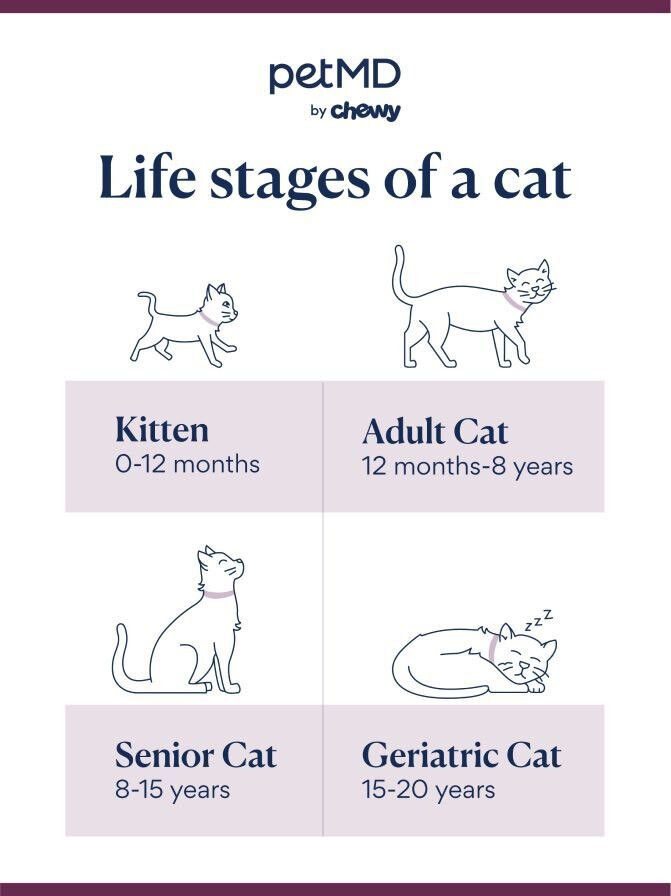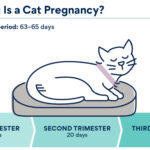Thanks to advancements in veterinary medicine, enhanced nutrition, and dedicated pet care, domestic cats are enjoying longer and healthier lives than ever before. As a devoted cat parent, it’s your responsibility to actively participate in your feline companion’s journey to their golden years by providing tailored care at each stage of their life.
If you’ve ever pondered about your cat’s age in human years and how long cats typically live, the answer is multifaceted. It largely depends on the collaborative approach you and your veterinarian take concerning your cat’s nutritional needs, vaccination schedule, oral health maintenance, and environmental enrichment as they mature.
This comprehensive guide delves into the average lifespan of domestic cats and offers valuable insights into how you can contribute to extending your beloved cat’s life.
Key Insights:
- A cat’s diet, proactive healthcare, and whether they are spayed or neutered are significant determinants of their lifespan.
- Building a strong partnership with your veterinarian is crucial to ensure your cat receives optimal care for a long and healthy life.
- Any changes in your aging cat’s behavior should be promptly discussed with your veterinarian for timely intervention.
Decoding the Average Lifespan of a Cat
The typical domestic cat lifespan ranges from 13 to 17 years. Remarkably, some felines surpass this average, living for 20 years or more. Creme Puff, the record holder for the oldest cat ever documented, reached an astounding 38 years of age.
Several elements influence a cat’s longevity, including:
-
Nutrition: A complete and balanced diet is foundational for a cat’s health, supplying the necessary nutrients, vitamins, and minerals that support proper organ function, a robust immune system, and maintaining a healthy body weight.
-
Lifestyle: A cat’s lifestyle has a direct impact on its lifespan. Indoor cats generally live longer than outdoor cats. This is primarily because they are shielded from environmental hazards and have consistent access to preventive veterinary care, thanks to their owners.
-
Preventive Care: Cats that receive comprehensive vaccinations and regular blood work benefit from early detection and treatment of potential health issues. Consistent preventive medications for fleas, ticks, and heartworm also contribute to a longer lifespan by preventing parasite-borne diseases.
-
Breed: Certain cat breeds are known for their longevity compared to others. For instance, Siamese cats often outlive Maine Coons. Siamese cats tend to have fewer breed-specific health problems, whereas Maine Coons, being larger, are predisposed to certain health issues related to their size.
- Mixed-breed cats frequently exhibit greater lifespan compared to purebred cats due to hybrid vigor. The genetic diversity in mixed breeds often leads to enhanced health and fewer inherited health conditions.
- Tabby cats, recognized by their distinctive coat pattern rather than being a specific breed, can impressively live for 15–20 years on average.
-
Genetics: A cat’s genetic makeup and predisposition to certain diseases can influence lifespan. Genetic testing is advisable before breeding cats to minimize the transmission of hereditary conditions.
-
Spaying/Neutering: Spaying or neutering cats is associated with increased lifespan compared to intact cats. Unspayed cats have a higher risk of developing reproductive cancers due to hormonal imbalances.
 cat life stages; how long do cats live
cat life stages; how long do cats live
Indoor vs. Outdoor Cat Life Expectancy
Sadly, outdoor cats, or those with frequent outdoor access, typically have a lifespan only about half as long as indoor cats. Outdoor environments present numerous dangers to cats, including:
- Infectious diseases from wildlife or other felines
- Injuries from predators or traffic accidents
- Parasites like fleas, ticks, and intestinal worms
While some cats may benefit emotionally and behaviorally from supervised outdoor activities such as leash walking or secure outdoor enclosures, most cats thrive as indoor-only pets when provided with a stimulating and enriched indoor environment. Indoor cats benefit from longer lifespans due to protection from external threats and consistent access to balanced nutrition and veterinary care.
Navigating Cat Life Stages
Cats progress through distinct life stages, each with unique behavioral and health requirements.
Kitten (Birth to 1 Year)
The kitten stage is a period of rapid growth and learning. During this formative time, kittens develop essential social and environmental interaction skills. While basic habits like litter box use and feeding are usually instinctive, socialization and engaging in appropriate play are crucial for behavioral development. Interactive toys like laser pointers are excellent for stimulating a kitten’s mind and encouraging physical activity.
Kittens require a diet specifically formulated for growth, as their caloric needs are higher to support their rapid development. Kitten food should bear an Association of American Feed Control Officials (AAFCO) nutritional adequacy statement indicating it provides “complete nutrition for growing kittens.”
Kittenhood is also the critical period for initiating protective vaccinations, such as FVRCP, rabies, and FeLV vaccines. Spaying or neutering is typically recommended around 6 months of age to minimize the risks of certain cancers and undesirable behaviors like urine marking.
Young Adult (1–6 years)
Young adult cats remain active and playful but have completed their physical growth. Their caloric needs decrease, and they should transition to adult cat food. Maintaining a healthy weight during this stage is crucial for preventing future health issues such as arthritis and diabetes.
Routine vaccinations and health examinations remain important, even though young adult cats are generally less susceptible to illness. However, certain conditions like asthma and feline lower urinary tract disease (FLUTD) are more commonly diagnosed in this age group. Early detection and management are key for long-term health. Baseline blood work can be beneficial to establish normal health markers for future comparisons as the cat ages.
Mature Adult (6–10 years)
Mature adult cats may exhibit a decrease in activity levels, becoming less playful and more sedentary. Changes in behavior, such as altered litter box habits or nighttime activity, may become noticeable. Some older cats may become more active at night and sleep more during the day, or they may become less meticulous about their litter box habits.
Providing an easily accessible litter box, such as an uncovered one with low sides, can aid senior cats, especially those with mobility issues. These behavioral changes can indicate underlying conditions like arthritis, cognitive dysfunction, or early kidney or digestive problems. Annual blood work is essential for mature cats to monitor for early changes in kidney, liver, and thyroid function.
Regular monitoring of grooming habits, hairball frequency, and weight changes is also important. Oral health becomes increasingly critical, and dental cleanings should be considered based on veterinary recommendations, particularly for cats resistant to tooth brushing. Establishing a consistent dental care routine at home with cat-friendly toothbrushes and toothpaste is ideal for minimizing the need for professional dental cleanings and supporting long-term oral health.
Senior (10+ years)
The transition to the senior cat stage is variable. Some cats remain active and mobile well into their senior years, while others experience more age-related health issues. Biannual blood work and urine testing are recommended for cats aged 10 and older due to the potential for rapid changes in organ health. Senior cats are also more prone to blood pressure issues, which can lead to serious complications like strokes and blindness. Blood pressure monitoring should be part of routine senior cat checkups.
Senior cats often exhibit further slowing down, which can be indicative of untreated arthritis pain. Joint supplements may be beneficial; consult your veterinarian about incorporating supplements like Nutramax’s Cosequin for Cats to support joint health.
Strategies to Enhance Your Cat’s Lifespan
While immortality remains out of reach, there are numerous ways pet parents can positively influence their cat’s longevity.
- Maintain Up-to-Date Vaccinations: Vaccines tailored to your cat’s lifestyle are crucial for preventing diseases that can be challenging or impossible to treat. Remember that even indoor cats need vaccinations.
- Spay or Neuter Early: Unspayed or unneutered cats face a significantly higher risk of developing life-threatening reproductive diseases and cancers at a younger age.
- Commit to Preventive Care: Cats are adept at concealing illness. Annual veterinary checkups and routine blood testing are vital for early disease detection. A strong veterinarian-client-patient relationship improves the chances of noticing subtle changes during examinations. Promptly discuss any behavioral changes with your vet, even seemingly minor ones.
- Adapt Your Cat’s Environment: As cats age, environmental modifications are essential. Discuss joint supplements with your veterinarian if you observe your cat slowing down. Consider providing an orthopedic bed to offer enhanced cushioning and support for aging joints.
By proactively addressing your cat’s needs throughout each life stage and embracing these strategies, you can significantly contribute to a longer, healthier, and happier life for your cherished feline companion.
WRITTEN BY
Jamie Lovejoy, DVM
Veterinarian

